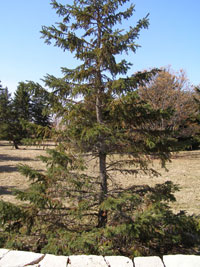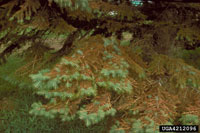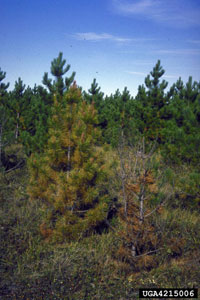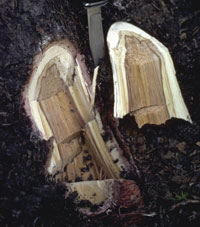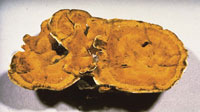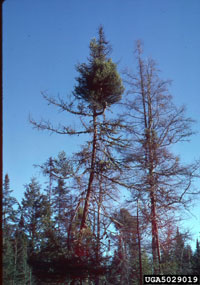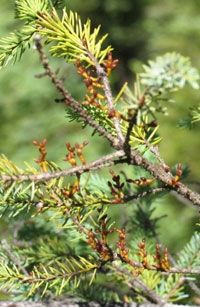Extension > Garden > Diagnose a problem > What's wrong with my plant? > Evergreen Trees > Spruce > Entire canopy is thin and growth is slow
Spruce > Whole tree> Entire canopy is thin and growth is slow
1 of 4
Rhizosphaera needle cast
Rhizosphaera kalkhoffii
- Infected needles turn brown or purplish brown late in winter or early spring
- Needles at the branch tips remain green, while older needles closer to the trunk of the tree become discolored
- Tiny black dots can be seen with a hand lens on infected needles
- Discolored needles fall off mid summer; tree looks thin and bare
- Damage typically starts on the lower branches and moves up the tree
- Most common on young Colorado blue spruce, but infects all spruces
- More information on Rhizosphaera needle cast
2 of 4
Armillaria root rot
Armillaria spp
- Infected trees have poor growth, dead branches in the upper canopy, browning needles, may produce an abundant crop of cones, and eventually die
- Clusters of honey-colored mushrooms may grow at the base of the tree in fall
- Flat white sheets of fungal mycelia (mycelia fans) grow between the bark and sapwood at the base of infected trees
- Thick black, shoestring-like fungal strands sometimes grow in a net on infected trees and in the soil around the base of the tree
- The base of the tree just below the soil surface may be encrusted in resin
- Wood is decayed, white, soft and stringy and may extend from the base of the tree well up into the trunk; trees frequently break or fall over in storms
- More information on Armillaria root rot
3 of 4
Tomentosus root rot
Inonotus tomentosus
- Heartwood of infected roots and trunks is initially reddish brown
- As infection continues white pocket rot develops; decayed wood has elongated pockets or pits, and may appear honeycomb-like in cross section
- Infected trees have reduced growth and thin canopies, produce large amounts of cones and eventually die
- Infected trees frequently break or lodge during storms
- Mushrooms that are velvety brown above and porous and buff colored below appear around the base of the tree in late summer
- More information on Tomentosus root rot
4 of 4
Eastern spruce dwarf mistletoe
Arceuthobium pusillum
- Witches’ brooms, a clump of small weak branches arising from one point on a larger branch, form in infected trees
- Needles within the witches’ broom remain green, needles on the rest of the tree yellow and fall off, typically from the top of the tree down
- Short (1/2 to 1 inch) brown to orange dwarf mistletoe stalks can be seen during the growing season but fall off after seed dispersal in August or September; this occurs only after 4 to 5 years of infection
- Most common on black spruce in northern Minnesota; white spruce are also very susceptible
- More information on Eastern spruce dwarf mistletoe



